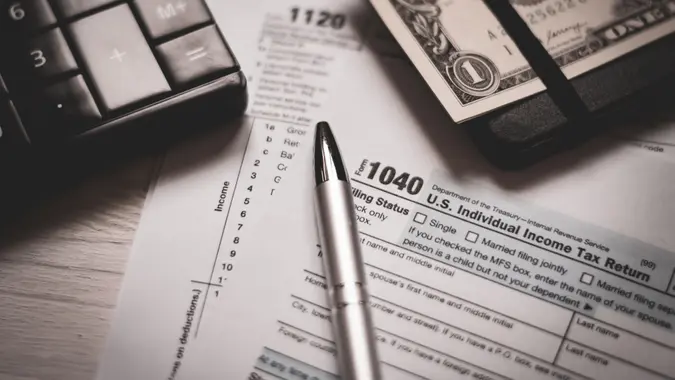9 Tax Breaks the Middle Class Should Know Of

Commitment to Our Readers
GOBankingRates' editorial team is committed to bringing you unbiased reviews and information. We use data-driven methodologies to evaluate financial products and services - our reviews and ratings are not influenced by advertisers. You can read more about our editorial guidelines and our products and services review methodology.

20 Years
Helping You Live Richer

Reviewed
by Experts

Trusted by
Millions of Readers
Paying taxes is never fun. But if you’re part of America’s middle class — defined as those who earn between two-thirds and double the median income — you could qualify for some tax breaks.
From tax deductions that lower your taxable income on a dollar-per-dollar basis to tax credits that reduce your tax liability, here are some tax breaks the middle class should know about.
Education Tax Breaks
Did you pay education costs last year? You could be eligible for a tax break or two.
“There are almost too many tax breaks related to education to keep track of,” said Mark Luscombe, CPA and principal analyst at Wolters Kluwer Tax & Accounting. “There are 529 plans and Coverdell Education Savings Accounts for tax-favored funding of future education expenses.”
With a 529 plan, your contributions aren’t tax deductible, but they can earn interest. You can use that money on qualified education expenses without paying federal tax.
A Coverdell education savings account is also meant for qualified education expenses. Contributions aren’t tax deductible, but distributions are tax-free when used for education expenses.
Others education tax breaks include:
- American Opportunity Tax Credit: A maximum $2,500 per eligible student to help with the first four years of higher education costs.
- Lifetime Learning Credit: $2,000 tax credit to offset the cost of undergraduate, graduate and professional degree courses. It can also help with job-related education.
- Student loan interest deduction: If you’ve paid student loan interest, you could deduct up to $2,500 in interest paid during the year.
- U.S. Savings Bonds: Some savings bonds qualify for a tax break when used to pay tuition and other qualifying education expenses.
Income limits and other criteria apply.
C-Corp Tax Breaks
If you’re a middle-class business owner, you could potentially qualify for a tax break by switching from an S-Corp to a C-Corp.
“Since the [Section] 199A deduction hasn’t really kept up with inflation, every year there are more taxpayers I see who would benefit from a C-Corp rather than an S-Corp,” said Crystal Stranger, senior tax director and CEO of OpticTax.
This tax break works for upper-middle-class taxpayers, too.
“For upper-middle-class taxpayers, the tax rate is often lower, especially if there are international sales that will qualify for the 13.125% effective tax rate after applying the Foreign Derived Intangible Income discount,” said Stranger. “And when selling the company only C-Corps are eligible for tax-free gains with the QSBS deduction, and S-Corp owners miss out.”
Qualified Retirement Plan Contributions
There’s also a tax break for saving for retirement.
For example, you could get the Saver’s Credit for contributing to a 401(k). This credit is up to $2,000 or $4,000 if married filing jointly. The exact credit amount depends on your income.
Contributing to other accounts, like an IRA, could also get you a tax break. Any contribution to a Traditional IRA is tax-deductible. Annual contribution limits depend on the year and your age. For 2024, you can contribute up to $7,000 or $8,000 if you’re 50 or older.
Tax Breaks for Charitable Donations
As per IRS rules, you can deduct up to 50% of your adjusted gross income (AGI) in charitable contributions. Some people can only deduct 20% to 30%.
To count, those charitable contributions must be made to a qualified organization like a public charity or private operating foundation. You’ll also need to itemize deductions, rather than take the standard deduction.
 Written by
Written by  Edited by
Edited by 

























